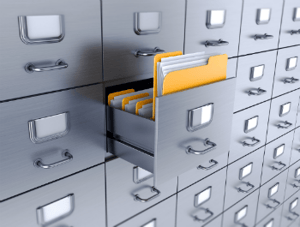How to Organize Your Filing System for Improved Efficiency
 The goal of organizing your company’s digital filing system is to be able to find what you need, when you need it – even if it’s months or years from today. Whether you store files locally (on office desktops, laptops, or mobile devices), in the cloud, or with the help of a dedicated company server, good file management practices will save you time, money, and endless frustration.
The goal of organizing your company’s digital filing system is to be able to find what you need, when you need it – even if it’s months or years from today. Whether you store files locally (on office desktops, laptops, or mobile devices), in the cloud, or with the help of a dedicated company server, good file management practices will save you time, money, and endless frustration.
Has your business ever experienced one of these situations?
- A customer or supplier calls to discuss their account, but you can’t seem to lay your hands on the specific invoice or sales document they’re calling about.
- One of your employees is off sick and unavailable – or worse, has left your employ permanently – and no one can find their project files for this afternoon’s client meeting.
- It’s year-end again, and you’re spending more time tracking down account documents than you are running your business. Last year, your company paid the price for its disorganized filing system with missed tax deductions and a costly tax audit.
If any of this sounds familiar, you’re not alone. A recent study of 18,000 business leaders revealed more than half were losing the equivalent of six working hours every week as a result of disorganization. The lack of an orderly filing system can negatively impact your business’s reputation, growth potential, and bottom line.
Electronic Filing System Basics
All you really need to create a more efficient filing system is an organized approach to using these basic filing components. Start by picking a storage system (local or cloud-based, for example) – or a combination of systems, if that works best for your business – and drill down from there. The key is to be consistent in your filing and maintenance habits.
Root Folders
Root folders are so-named for a reason. By providing a common base location for all business documents, they serve as ground zero for your filing system. The default root folder for individuals using Windows is the My Documents folder. But in a shared work environment, you’re better off using Shared Documents folders as your root storage location.
Main Folders & Sub-Folders
Depending on your business, the main folders inside your root folders might include Customers, Suppliers, and so on. But within those main folders, you should nest as many levels of sub-folders as you need to stay organized. Just make sure you use plain language to name all your folders, regardless of their location.
Under the main Customers folder, for example, you might have a folder named “Cathy Customer” that in turn contains a sub-folder named “Invoices”, that houses additional sub-folders labeled by individual year. The point is that anyone with access to your filing system should be able to understand what each folder contains, without having to open it.
Files
Part of your organizational goal should be to have every file your business creates stored in an appropriate folder. The other part should be to assign descriptive names to every document. The more specific your file names are, the less time you’ll spend opening and closing them to find what you need.
If, for example, the document you’ve just created is an email outlining the new terms you’ve agreed to with one of your vendors, don’t just name the file “Supplier Sam Email”. It’s unlikely you’ll ever remember what that particular email was about unless you spend time opening and reading it. Instead, qualify the file description with a name like “Supplier Sam Email New Terms Jan 15 2019” – or 01152019, if you prefer.
It’s also important to remember that, if your employees share documents over portable devices or email, the file paths will be missing. Since the recipient can’t see that the file you’ve just shared normally resides in the 2018 Customer Invoices sub-folder, implementing a policy to always name similar documents something like “Cathy Customer Invoice July 31 2018” when they’re created will save everyone time.
Keeping Your Digital Filing System Intact
Once your files have been organized for efficiency, make sure you keep them that way by intermittently weeding out old or inactive documents. Permanently deleting older files isn’t necessarily a good idea - even if you’re certain you no longer need them. Instead, consider moving them to a new folder labeled “Closed” or “Inactive”. If you’re using a local storage system, you can get old files out of your way by moving them to a separate hard drive.
Remember, the best time to file any document is when you create it, so get in the habit of naming and storing documents the right way, the first time. If you’re in a hurry - or are unsure of where a certain file is eventually going to live - you should at least make a point of saving it to your (hopefully uncluttered) desktop, where you’ll be more likely to see and deal with it properly later on.

Comments